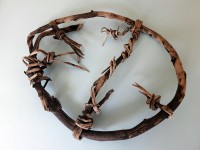 On August 5th, 2003, Simone Bartolini, cartographer and head of the State Borders division of Italy’s Military Geographical Institute, was in the Pfossental Valley in the Italian Dolomites doing a topographical survey of the border with Austria when he came across an old snowshoe made by hand out of birch and twine. A birch stick about 1.5 meters (five feet) long had been shaped into a rough oval closed with twine, and then more twine stretched taughtly across the middle to support the foot. One of the twine supports was broken in the middle, but otherwise it was in excellent condition.
On August 5th, 2003, Simone Bartolini, cartographer and head of the State Borders division of Italy’s Military Geographical Institute, was in the Pfossental Valley in the Italian Dolomites doing a topographical survey of the border with Austria when he came across an old snowshoe made by hand out of birch and twine. A birch stick about 1.5 meters (five feet) long had been shaped into a rough oval closed with twine, and then more twine stretched taughtly across the middle to support the foot. One of the twine supports was broken in the middle, but otherwise it was in excellent condition.
Bartolini thought it was maybe a hundred years old, the rudimentary work of a local farmer perhaps, and hung it on the wall of his office in Florence as a charming curiosity. That’s where it remained for 12 years until 2015 when Bartolini attended an exhibition of artifacts found in the glaciers at the Archaeological Museum of Bolzano. After a conversation with museum director Angelika Fleckinger, it dawned on him that his snowshoe might be a lot older than he had realized, so he gave it to the Office of Archaeological Heritage of Bolzano for further study.
Researchers had it radiocarbon dated by two independent laboratories and their results were the same: the snowshoe was made in the late Neolithic, between 3800 and 3700 B.C. That makes it 5,800 years old, by far the oldest known snowshoe.
“The shoe is evidence that people in the Neolithic period were living in the Alps area and had equipped themselves accordingly,” said Dr Catrin Marzoli, the director of the province’s cultural heritage department.
It was unclear why people were travelling through such an inhospitable region, she said. They may have been hunting animals, fleeing enemies from a rival tribe, or visiting pagan sites of worship.
If you live in an environmentally challenging region, you adapt. People gotta move sometimes for any number of reasons. The snowshoe was found at an altitude of 3,134 meters (10,280 feet) in the Gurgler Eisjoch pass which has been used by mountain travelers for thousands of years. Ötzi the Iceman, whose naturally mummified body was found just a few miles west of the snowshoe in 1991, was treading that well-worn trail between what are now Italy and Austria when he was killed, and microscopic evidence in his bones and digestive system indicate he had trod that path many times in his life. Ötzi died 500 years after that snowshoe was made.
The snowshoe will now join the Iceman on display at the South Tyrol Museum of Archaeology in Bolzano.
“Ho hum, guess I’ll hang this old thing on my wall.” 😀 It’s always an interesting thing when a find gets revisited and suddenly this new context opens up.
I wonder what exactly Ms Fleckinger said that got Bartolini reconsidering the item’s provenance.
According to what I’ve read, the glaciers in the Adamello-Presanella Alps in between Austria and Italy just revealed two WWI bodies from the Austro-Hungarian Army and just a couple of weeks ago one from the opposing Italian forces. Obviously, the snowshoe is 58 times as old :confused:
As it turns out, they successfully made ‘Ötzi’ Italian. But I guess that from an ‘alpine point of view’, the Iceman might have been a ‘southerner’ anyway. I could imagine, however, that similar snowshoes might have been an add-on to his own boots – All it takes is twigs and some fiber.
The last two sentences of your second paragraph were similar my own thoughts, Henri. That snowshoe reminds of the clamped on chain devices we used on our galoshes here as a boy to trudge to school in when things got icy.
They weren’t meant to keep you on top of the snow, they were meant to give traction on the ice below and long open patches of the same. Nothing like breaking your tail bone or arm trying to navigate a a patch of rock hard ice over pavement. My tailbone just twinged in arthritic pain from typing about the experience. The things are still on the market.
I suspect these were used the same way for ascending and descending the passes. Definitely beats getting maimed or killed in a long slide from losing your footing.
One can gain traction by simply wrapping one’s footwear with vines or twine. Snowshoes are a different matter, requiring preparation. The wood must be flexible and either green or damp enough to bend and be bound until it is stiff enough to hold shape, so made during warmer weather. More twine (or leather strips) would then be intertwined to provide a surface to which the foot (well-insulated) could be bound. I learned to make snowshoes similar to this when I was young. Modern snowshoes retain the same principles and basic design. Have not shoed in the Alps, but have done considerable in the Colorado Rockies. I assure you that the fine powder of cold high elevations requires support. Ice layers rarely form: the air is thin and dry, and any snow approaching liquid form disappears rapidly. Small streams protected by a snow layer are a dangerous exception, and an experienced shoer knows how to look for the signs of one. A bigger issue is crashing through air pockets created by buried shrubs and outcrops. One learns to lay flat and swim out.